Food Security and Food Aid
The issues of security, food aid and malnutrition make a complex system of intertwined aspects. Food security deals with the right and the physical and economic access of human beings to food, not only dependent on supply but also on employment, income, political and social implications.
Procedures undertaken to assess problems of food insecurity are described by the Sphere Project and by Médicins Sans Frontièrs. Possible responses to a scarcity of food security:
Possible responses to a scarcity of food security:
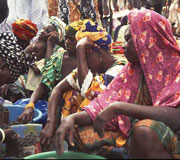 Survey
Survey
If a food insecurity exists, at first a thorough survey has to be undertaken, to find out whether it actually derives from a food shortage or if it originates from social and political hindrances.
Survey (local institutions are to be involved):
- How was food acquired before the shortage?
- How do contemporary coping strategies function?
- Do local aid programmes exist?
- Relations between a host and a displaced population?
- Conditions produced by urban or rural setting?
- What are social and economic policies and political complications in their national and international context?
If the independence and self-sufficiency of a population is to be supported, at first an assessment of the possible means of aid should be carried out, and food distributions are to be chosen as the last option. If people’s lives are at risk because of a lack of food, responses prioritize their immediate food needs.
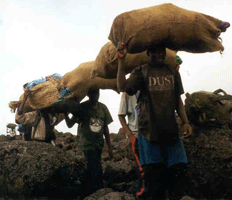 Coping Strategies
Coping Strategies
Contemporary coping strategies of the population are to be investigated and analyzed as to whether they are sufficient or integrable into the relief programme, or if they are instead damaging. Food aid should be implemented before non-damaging strategies are outsourced.
Early coping strategies without any damage:
- Collection of wild foods.
- Selling non-essential assets.
- Sending family member to work elsewhere.
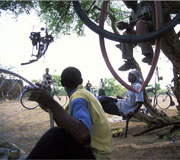 Dangers of coping strategies:
Dangers of coping strategies:
- Cutbacks in the amount and quality of food eaten and on expenditures like school fees and healthcare.
- Sale of household assets and land may reduce productivity.
- Failure to repay loans.
- Migration and separation of families may weaken care of weak members/ children.
- Producing or trading illegal goods risks criminalization.
- Travel to insecure areas for work or to gather food or fuel might expose individuals to physical violence/HIV.
- Social demeaning activities like prostitution undermine dignity, risk social exclusion and expose to violence/HIV.
- Over-exploitation of natural resources, eg. deforestation reduces natural capital.
Supporting primary production and infrastructure:
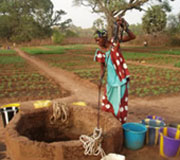 Infrastructure:
Infrastructure:
Repairing or constructing roads to provide safe access to markets for selling production or purchasing food can be the first step of reestablishing food supplies.
Repairing or constructing irrigation systems can enhance the productivity of agriculture.
Distribution:
- Seeds, tools, fertilizer, livestock, fishing and hunting equipment, market information, transport facilities.
- Adapted to local climate and conditions, if possible purchased locally.
- New technologies only if they are understood.
- Delivery should comply with planting and husbandry seasons.
- Destocking livestock may reduce the pressure of animal grazing on a pasture during a drought.
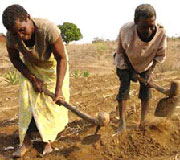 Complications:
Complications:
- Shouldn’t disturb traditional networks.
- Purchase of local products should not lead to shortage of supplies and rising prices.
- Food crops shouldn’t be replaced by cash crops.
- Avoid environmental problems, do not outsource natural resources and consideration of preparation demands, eg. beans needing more fuel for cooking.
- Avoid social conflicts: competition about scarce natural resources like land and water.
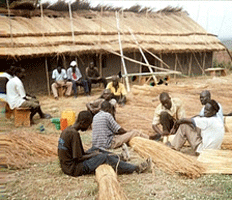 Employment and denumeration programmes: Food for Work/ Cash for Work
Employment and denumeration programmes: Food for Work/ Cash for Work
Activities that are of benefit for people themselves, payed by cash or food
Food for cash is to be preferred when:
- Weak markets or food shortages.
- When women are more likely to control the use of food than cash.
- When there are security problems in the distribution of cash.
Cash for work is to be preferred when: Food is available, and distribution is safe.
Complications:
- Employment shouldn’t take attention off other tasks, eg. childcare.
- Should broaden the range of activities, not replace productive ones that are already in place.
- Wage should be high enough to meet purchasing demands, also considering healthcare, school fees etc., but not lead to wage inflation and envy.
- Employment possibilities should be offered both to displaced and to local populations, concurrence should be avoided.
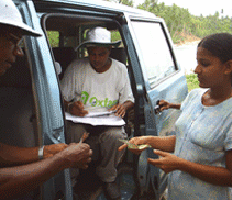 Cash distributions, food distributions and sales of subsidized food
Cash distributions, food distributions and sales of subsidized food
There are different kinds of free distributions, depending whether food is available or not:
- If food is available on the market, but a certain population group lacks the means to purchase, cash distributions can be made.
- If there is a food shortage but the population has purchasing power, subsidized food can be sold.
If there is a food shortage and the population has no purchasing power, free food distributions are to be given, but only when absolutely necessary, in combination with restoring long-term food security, discontinued as soon as possible and targeted at those who need most.
- The Distribution should be equal and controlled, so that weak members of the population like elderly and disabled are reached.
- Import only if there is an in-country deficit.
- Impartility, fairness and tranparency in contracting the food.
 Food
Food
If people have some food themselves, distributions should only fill the shortage.
Kind of food
- Ready to eat emergency rations or mass feeding of cooked food should only be chosen in acute survival needs following a major sudden disaster or population move.
- Culturally known food and dry rations for home preparation are preferable.
- Powdered or liquid milk shouldn’t be included in general food distributions as if inappropriately used, it may transfer disease vectors.
 Food preparation
Food preparation
- Distributed foods shouldn’t require long cooking times or large quantities of water.
- Grains should be milled as this reduces their cooking time, but whole grains have a longer shelf life, thus milling facilities in households or at a communal base serve best.
- Energy saving preparation, like cutting food into small pieces before cooking, using a lid, etc. should be promoted.
- Collection of fire wood should not degrade the environment, or expose women to dangerous situations.
- Access to sufficient water, milling facilities and fuel is important for healthy and efficient meal preparation.
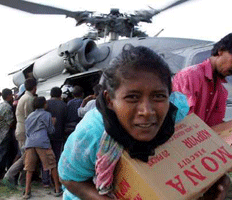 Packaging, Storage and Distribution
Packaging, Storage and Distribution
Packaging
- Should allow direct distribution without any repacking.
- Sturdy and convenient for handling and storage.
- Labeled in appropriate language incuding expiry date and details of nutrient.
- Package not may carry political or religious messages.
Warehousing
- Preferably for food only, dry, hygienic, protected from climatic conditions and uncontaminated by chemicals or other residues.
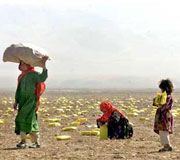 Distribution points
Distribution points
- Safe and convenient access for recipients, not only logistically convenient for the distributing agency.
- Frequency of distributions and distribution points according to travelling time of recipients.
- Not a long distance and distribution at convenient times.
- Secure safety, guarding distribution points, especially women, children, elderly and disabled.
Dropping goods off flights:
- No equal distribution.
- Loss of some amount.
- Might be dangerous if falling in mined fields.



